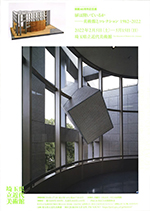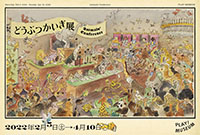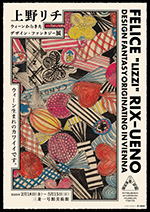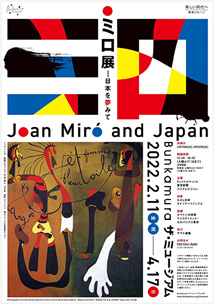 |
Picks is a monthly sampling of Japan's art scene, offering commentary by a variety of reviewers about current or recent exhibitions at museums and galleries around the country.
Note: Although Japan's state of quasi-emergency has been lifted, many museums and galleries still require reservations or have other anti-Covid measures in place. If you are planning a visit, please check the venue's website beforehand. |
 |
 |
|
|
 |
 |
 |
 |
| Is the Door Open? Tracing the 40-year History of MOMAS and Its Collections |
| 5 February - 15 May 2022 |
The Museum of Modern Art, Saitama
(Saitama) |
 |
|
This show shines a spotlight not only on the museum's collection, but also on materials about its history, exhibitions, and acquisition process, as well as its famed designer, architect Kisho Kurokawa. The voluminous offering of Kurokawa's drawings, plans, models, construction photos, and geological samples for the project helps illuminate the way in which MOMAS has come into its own as a pioneering innovator among regional museums in Japan. |
|
|
 |
 |
 |
 |
 |
| Animals' Conference |
| 5 February - 10 April 2022 |
Play! Museum
(Tokyo) |
 |
|
A group exhibition inspired by the titular 1949 picture book by the German writer Erich Kastner (1899-1974) and the Czech-German illustrator Walter Trier (1890-1951). It opens with a lion, an elephant, and a giraffe venting their anger at humans for going to war. Works by eight artists (Hiraku Ueda, Kyoko Umezu, Tomoko Konioke, Junaida, Naoya Hata, Seiichi Hishikawa, Tomoyasu Murata, and Shinsuke Yoshitake) follow the plot of Kastner's tale, tragically timely now as humans, too, try to come to grips with the invasion of Ukraine.
|
|
|

|
 |
 |
 |
 |
 |
 |
| Felice "Lizzi" Rix-Ueno: Design Fantasy Originating in Vienna |
| 18 February - 15 May 2022 |
Mitsubishi Ichigokan Museum, Tokyo
(Tokyo) |
 |
|
Born in Vienna, Lizzi Rix (1893-1967) moved with her husband, architect Isaburo Ueno, to Japan, where she became known for vibrant, colorful designs, mainly for textiles, featuring familiar natural motifs like flowers, trees, birds and fish. Some of her works take their inspiration from traditional Japanese patterns. The word "fantasy" suggests flights of fancy that bring happiness to people, which is arguably the purpose of design. Certainly Rix-Ueno's creative flights do just that. Showcasing some 370 works, this is the first full-scale retrospective of her career to be held anywhere.
|
|
|
 |
 |
 |
 |
 |
| Joan Miró and Japan |
| 11 February - 17 April 2022 |
Bunkamura Museum of Art
(Tokyo) |
 |
|
Barcelona-born Miró (1893-1983) ranks with Picasso as one of the giants of contemporary Spanish art. Though his name is well known in Japan, few people here are aware that he had a deep understanding and appreciation of Japanese culture. This show seeks to elucidate that connection by introducing early works that reflect Miró's interest in Japan from a young age, as well as later masterpieces and the first works he exhibited in Japan. (For a detailed review, see the March 2022 Focus.)
|
|
|
|
|
|
|
|

|
 |
 |
|
 |
 |
 |
 |
| Chasing the Horizon: 1952-2022 -- Ancient, Impressionist, and Contemporary Art |
| 29 January - 10 April 2022 |
Artizon Museum
(Tokyo) |
 |
|
Founded in 1952 by Shojiro Ishibashi, head of the Bridgestone Tire Company, the Bridgestone Museum of Art was a pioneer among postwar privately-owned art museums in Japan. In 2015 the Bridgestone closed for renovations, reopening in 2020 with a new name, the Artizon Museum. This show reviews the institution's seven-decade history through a presentation of some 170 artworks and related documentation, as well as a display of exhibition posters and other archival materials, among them Shojiro's journals of his travels to Europe and North America. |
|

|
 |
 |
 |
 |
 |
 |
 |
| Shigeru Hasegawa + O Jun: "Paint-Tengu" |
| 8 January - 3 April 2022 |
Museum Haus Kasuya
(Kanagawa)
|
 |
|
According to the museum website: "O Jun and Shigeru Hasegawa started gaining attention as artists of the New Figurative Painting in the 1990s. Since then, the two artists have been paying notice to each other for over 30 years. This exhibition is a first joint exhibition of O Jun and Hasegawa, two connoisseurs who are also involved in exhibition curation. Visitors will see how they find each other's works, and be amazed by the atmosphere created through an encounter between these painters." |
|
|
 |
 |
 |
 |
 |
| Lineage of Ordinaries: The Beautiful World of Edo Painting from the Tsuruga Municipal Museum |
| 12 March - 8 May 2022 |
Fuchu Art Museum
(Tokyo) |
 |
|
Edo-period (1603-1867) works from the collection of the titular museum in Tsuruga, Fukui Prefecture, have frequently appeared in the Fuchu Art Museum's annual Spring Edo Painting Festival. This year's installment offers a welcome opportunity to get a thorough look at the Tsuruga's holdings. Ranging from Yamato-e to works of the Maruyama-Shijo school, all of these paintings derive from the vision of artists relentless in their pursuit of the beauty to be found in the "ordinary" world. |
|
|
|
|
|
|
 |
 |
 |
 |
| Kaburaki Kiyokata: A Retrospective |
| 18 March - 8 May 2022 |
The National Museum of Modern Art, Tokyo
(Tokyo) |
 |
|
Nihonga painter Kiyokata (1878-1972) started out as an illustrator in the ukiyo-e style and never forgot his roots; to the end of his life he looked for inspiration in the lives, writings, and entertainments of everyday people. This exhibition organizes his oeuvre under a number of themes resonating with those perennial interests. Despite living through such upheavals as the Great Kanto Earthquake of 1923 and the Second World War, Kiyokata did not waver in his beliefs or his approach to art even as the lives and values of those around him underwent profound changes. There is much food for thought here for those of us struggling to make sense of life in a time of natural disasters, pandemics and wars today. |
|
 |
 |
 |
 |
 |
| The Saint Kuya and Rokuharamitsuji Temple |
| 1 March - 8 May 2022 |
Tokyo National Museum
(Tokyo) |
 |
|
Commemorating the 1,050th anniversary of the death of the Japanese Buddhist saint Kuya (903-972), an itinerant monk who popularized Pure Land teachings, this show boasts the oldest surviving sculpture of Kuya, on view in Tokyo for the first time in a half-century. Accompanying the statue are other masterpieces of Heian- and Kamakura-period sculpture housed at Rokuharamitsuji, a temple in Kyoto founded by Kuya -- among them the Four Deva Kings as well as a Jizo said to be the work of the great sculptor Jocho (d. 1057). |
|
|
|
|
 |
|